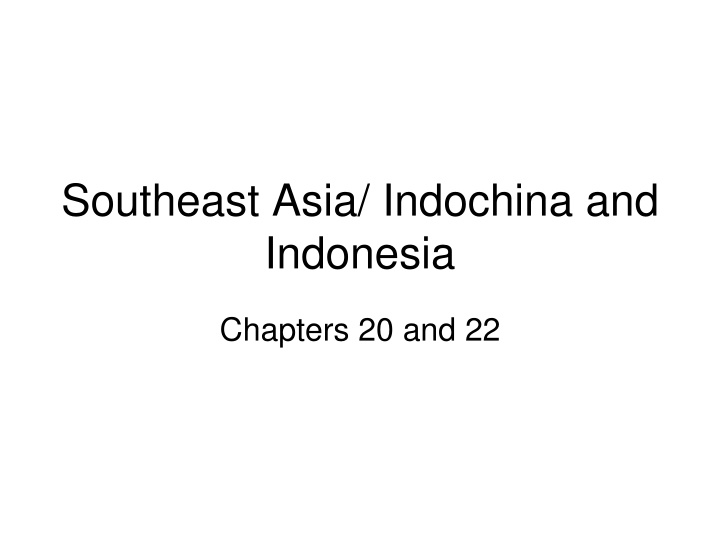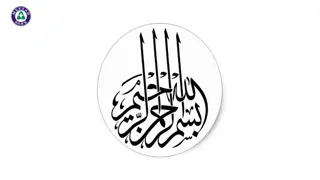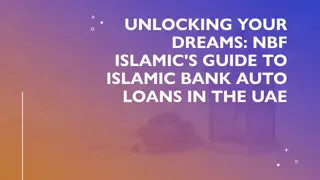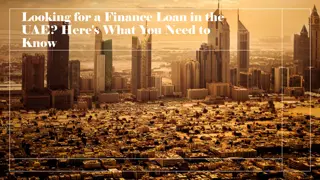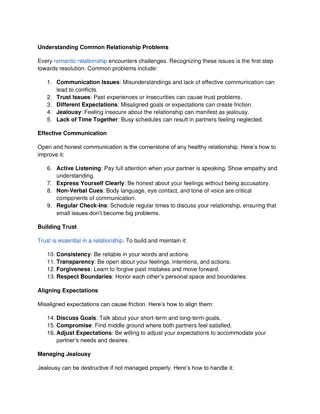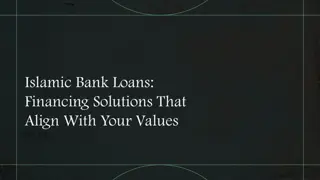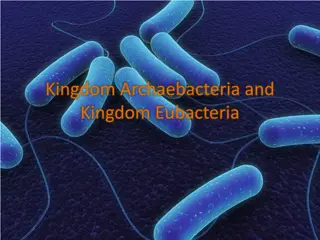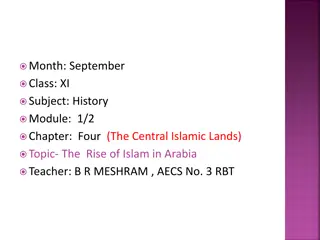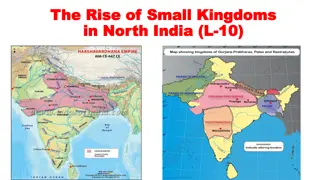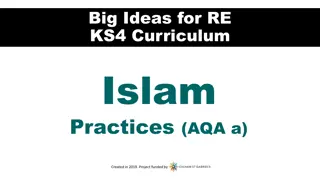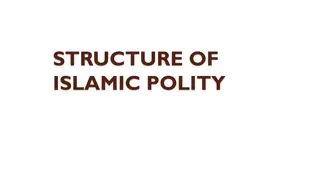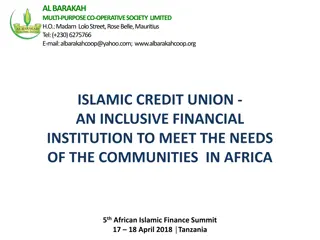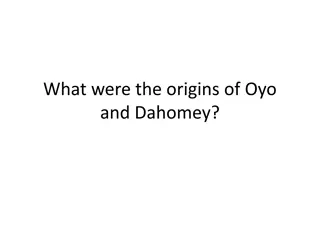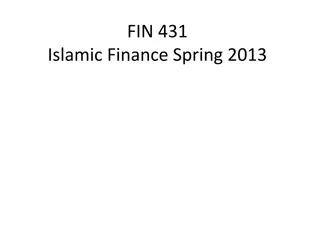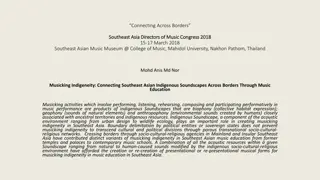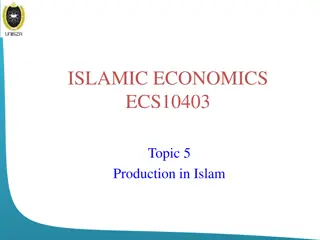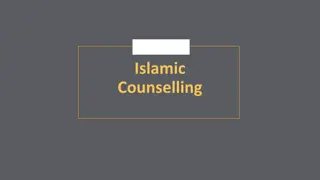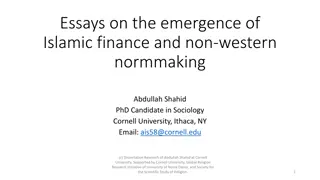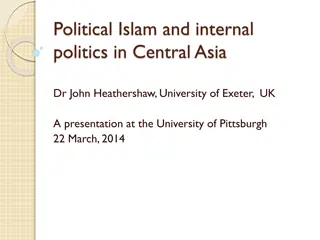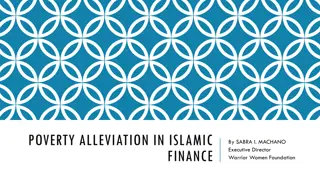Influence of Indian and Islamic Kingdoms in Southeast Asia
Southeast Asia, comprising mainland and archipelago regions, has a rich history of ancient kingdoms influenced by India and China. The Khmer Empire in Cambodia, Srivijaya in Sumatra, and the Sultanate of Malacca in Malaysia are key examples. These kingdoms evolved unique cultures blending Hinduism, Buddhism, and Islam, shaping the region's heritage. The arrival of Islam in the 12th century transformed Southeast Asia as Muslim traders established thriving sultanates. This historical background showcases the complex interplay of religious and cultural influences in the region.
Download Presentation

Please find below an Image/Link to download the presentation.
The content on the website is provided AS IS for your information and personal use only. It may not be sold, licensed, or shared on other websites without obtaining consent from the author.If you encounter any issues during the download, it is possible that the publisher has removed the file from their server.
You are allowed to download the files provided on this website for personal or commercial use, subject to the condition that they are used lawfully. All files are the property of their respective owners.
The content on the website is provided AS IS for your information and personal use only. It may not be sold, licensed, or shared on other websites without obtaining consent from the author.
E N D
Presentation Transcript
Southeast Asia/ Indochina and Indonesia Chapters 20 and 22
Regions of SE Asia: Pg 587 Video: Life in SE Asia Contains Mainland and islands Mainland has 2 peninsulas: Indochinese Peninsula and Malay Peninsula Mekong River drains water from China to South China Sea. Islands are part of an archipelago and most are inhabited. Both areas has tropical climate with monsoon rains, but not fertile soil. Most people are farmers and are very poor.
Indian Influence in Southeast Asia: Page 602 Southeast Asia has been inhabited since pre- historic times. The communities in the region evolved to form complex cultures and kingdoms with varying degrees of occupation and influence from India and China. The ancient kingdoms can be grouped into two categories. The first is agrarian kingdoms, which are based on agriculture. The second is maritime kingdoms, which are based on sea trade. Most agrarian kingdoms were located on mainland southeast Asia. One example is the Khmer Empire.
The Khmer Empire was an ancient kingdom of SE Asia in the 6th century. The Cambodians, or Khmers migrated from India, established an empire in what is today Cambodia and Laos. The capital was established in the area of Angkor. The Angkor period (889 1434), the golden age of Khmer civilization, saw the empire at its greatest extent. The Khmer civilization was largely formed by Indian cultural influences. Buddhism flourished side by side with the worship of Shiva and other Hindu gods. The greatest achievements of the Khmers was in architecture and sculpture. In 1434, after the Thai captured Angkor. This event marks the end of the brilliance of the Khmer civilization. Khmer Empire The Hindu Angkor Wat temple, the largest temple in the world, was built in the 1100s AD.
Other Kingdoms The first dominant power in the archipelago was Srivijaya in Sumatra. From the fifth century CE, the capital, Palembang, became a major seaport and functioned as a type of warehouse on the Spice Route between India and China. Srivijaya was also a center of Buddhist learning and influence. Srivijaya's wealth and influence faded when changes in nautical technology in the tenth century CE enabled Chinese and Indian merchants to ship cargo directly between their countries. It also enabled the Chola state in southern India to carry out a series of destructive attacks on Srivijaya. Hindu temple from the kingdom of Srivijaya. The root jaya means excellence.
The Arrival of Islam Muslim traders started to visit Southeast Asia in the Twelfth Century CE. Pasai was the first Muslim kingdom. The Sultanate of Malacca, founded by a Srivijayan prince, rose to prominence with the support of China and assumed Srivijaya s role. Islam spread throughout the archipelago in the 13th and 14th century at the expense of Hinduism with Malacca functioning (after its rulers converted) as the center of Islam in the region. Malacca Sultanate Palace is an exquisite piece of Malay architecture and is a replica of the original 15th century palace of Malacca's extinct Sultanate.
Influences of China and India: Pg 643 China made Vietnam and most of Indochina part of Chinese empire. Vietnam became independent in 939 ad. India never ruled, but great influence. Ideas migrated to area: Cultural Diffusion Hindu Buddhism Confucianism Writing systems Literature Ideas about gov t and social class.
The Arrival of the Europeans: pg 645 Europeans first came to Southeast Asia in the sixteenth century. It was the lure of trade and spices that brought Europeans to Southeast Asia. Christianity and Islam Portugal was the first European power to establish themselves in the lucrative Southeast Asia trade with the conquest of the Sultanate of Malacca in 1511. The Netherlands and Spain followed and soon overcame Portugal as the main European powers in the region. have to be categorized, Philip II of Spain could be placed with Napoleon Bonaparte and Adolf Hitler. All three inflicted death and destruction upon numerous people and nations. Philip II, King of Spain 1556- 1598, (1527-1598): If people The Dutch, acting through the Dutch East India Company took over Malacca from the Portuguese in 1641 while Spain began to colonize the Philippines (named after Philip II of Spain) in the 1560s.
Britain, in the form of the British East India Company, came relatively late onto the scene. They temporarily possessed Dutch territories during the Napoleonic Wars and in 1819 established Singapore as the key trading post for Britain in their rivalry with the Dutch. By 1913, the British occupied Burma, Malaya, and the Borneo territories, The French controlled Indochina (Vietnam, Laos and Cambodia), the Dutch ruled the Netherlands East Indies (much of today s Indonesia), The U.S. conquered the Philippines from Spain, and Portugal still managed to hold on to the island of Timor. Only Thailand was spared the experience of foreign rule even though they were influenced by the western powers.
Colonization, Good or Bad? Colonial rule had a profound effect on Southeast Asia. While the colonial powers profited much from the region's vast resources and large market, colonial rule did develop the region to a certain extent. A network of roads, bridges, and railroads was built. Modern schools and universities were constructed. Formalized governments and judicial systems were put in place. However, cash crop farming was enforced which benefited the West but caused rice production to fall leaving the people without enough to eat.
The Fight for Independence The institutions brought in by the colonial powers such as formal government, courts of law, print media, and modern education sowed the seeds of the for a nationalist, or independence, movement. The Japanese Occupation in WWII was the turning point for these movements. Japan broke the myth of the white man s superiority and galvanized these groups. Many nations were in turmoil. Most governments turned into military dictatorships: ruled by one man whose power comes from the military.
Free at last ! East Timor Independence Rally - August 1999 Indonesia declared independence on August 17, 1945 and then fought a bitter war against the Dutch. The Philippines were granted independence in 1946. Burma secured theirs from Britain in 1948. The French were driven from Indochina in 1954 after a bitterly fought war against the Vietnamese nationalists. Others soon followed. Britain ended its protectorate of the Sultanate of Brunei in 1984 marking the end of western rule in Southeast Asia. In 1975, Portuguese rule ended in East Timor. However, independence didn t last long as Indonesia annexed the territory soon after. It wasn t until 2002 until East Timor gained its formal independence.
Vietnam and War: Pg 655 China ruled Vietnam until 939 AD, then took over again until 1428. Chinese built roads and waterways, metal plows, farm animals, and irrigation methods. However, Vietnamese protected their own culture and traditions. Vietnam hasn t seen peace and growth since 1428. 1858 Napoleon of France invaded Vietnam, Cambodia and Laos. (Indochina) and colonized it! France took majority of resources. Most people were poor farmers who couldn t afford land. After WWII, Vietnam organized under Ho Chi Minh (communist leader) to fight for independence. France tried to hang on to it, but needed help. Asked US to help.
Lessons of a Lost War (see video after this slide) The US was worried about the spread of communism (Domino Theory!), sent money and weapons. Never declared war!!! In 1954 an agreement was signed to divide Vietnam into Communist North Vietnam and US supported South Vietnam. The US jumped in on the fight after the Gulf of Tonkin incident. US sent in military support to South Vietnam to fight against the Viet Cong, or North Vietnamese. 1965 US started bombing North Vietnam. US President Lyndon B. Johnson continued to increase US troops in Vietnam. By 1973 the US public grew tired of seeing troops die on TV (1st war publicly viewed on TV.)
End of War: Nixon (See Video) Pg 657 Richard M. Nixon ran on the platform promising the withdrawal of troops from Vietnam. After being elected as president, he slowly decreased the number of troops as Vietnam and Cambodia continued to be bombed. By 1975 North Vietnam and Ho Chi Minh s troops overran South Vietnam. The end of the war was signaled by the fall of South Vietnam s capitol, Saigon, which was renamed Ho Chi Minh City after the war. Many South Vietnamese people were punished for supporting democracy. Hundreds of thousands South Vietnamese fled as refugees to the United States and other surrounding countries.
Vietnam Today: Pg 658-659 Vietnam is now a communist nation, which people elect representatives to the national assembly, then chooses a prime minister. The Politburo heads the communist political party. Government owns and runs industries, services and economy: restricts trade with other nations. Educated people fled after the war. Most people are poor farmers. In order to improve the economy, Vietnam encouraged more private control of some industries. More supply and demand.
Govt owns all land, but farmers can work it as they choose. Most grow rice, the primary agricultural product. Food processing, especially seafood, is exported to Japan, Germany and US (US started trading again in 1994) Biggest boost to economy: international trade and allowing foreign businesses to invest, set up companies in Vietnam. Some families live in cities live in apartments. Common for extended families to live together. Farming, Industry and Homes Most people are poor and live in rural areas. Wooden or bamboo homes or on houseboats.
Philippines Spain originally colonized the Philippines for natural resources (Part of the Spice Islands/ Spice Route) Established Spanish as main language. Only Christian country in SE Asia (Catholic) (Pg 645) 90% of Pilipino are Christian. US won the Spanish-American war: Fighting over Cuba: was awarded Philippines, Guan and Puerto Rico After WWII Philippines was granted their independence from the US. Democracy Video on Life in the Philippians.
In 1965 Ferdinand Marcos was elected president. However, once in power, he stole money from the treasury and ruled more like a dictator. Life was difficult under his rule. After 20 years of ruling harshly with limited personal freedom, Marcos was forced out of office by Corazon Aquino in 1986. She became president. Video on Marcos. Video on People and Places 245px-Ferdinand_Marcos_at_the_White_House 225px-Cory_Aquino_during_a_ceremony_honoring_US_Air_Force Imelda Marcos
Pol Pot: Leader of Death and Destruction Cambodia Land in Transition Video Saloth Sar (May 19, 1925-April 15, 1998), better known as Pol Pot, was the ruler of the Khmer Rouge Party and the Prime Minister of Cambodia from 1976 to 1979. During his time in power Pol Pot created an aggressive regime of agricultural reform, designed to create a utopian Communist society which was known for repressing intellectuals. Today the excesses of his government are widely blamed for causing the deaths of up to two million Cambodians. (Genocide!) Pol Pot in his younger days
Cambodian Genocide Pol Pot's regime killed between 1.5 to 2.3 million people between 1975-1979, out of a population of approximately 8 million. The regime targeted Buddhist monks, Western educated intellectuals, people who appeared to be intelligent (for example, individuals with glasses), the crippled and lame, and ethnic minorities like ethnic Laotians and Vietnamese. The skulls and bones of just a fraction of Pol Pot s victims many of whom were shackled and forced to dig their own mass grave.
One Vision of a Communist Utopia The Khmer Rouge ordered the complete evacuation of Phnom Penh and all other major towns and cities. Those leaving were told that the evacuation was due to the threat of severe American bombing. Pol Pot's regime had read the Marxist theory that cities are parasites on the countryside, that only labor value is true value. Therefore, immediately after they took power, the Khmer Rouge evacuated all the cities at gunpoint, including those who were not supposed to be moved, such as patients in hospitals and newborns. The Khmer Rouge leadership boasted over their radio station that only one or two million people out of the population were needed to build the new agrarian communist utopia. As for the others, as their proverb put it, "if they survive, no gain; if they die, no loss. Pol Pot continued to rule his party even after he resigned and up to shortly before his death. This incident is the basis for the movie The Killing Fields.
Is it Myanmar or Burma? The name "Myanmar" comes from the two words "myan", which means "swift", and "ma", which means "strong". In 1989, the military junta (military dictatorship form of government) officially changed the English version of its name from Burma to Myanmar. The renaming proved to be politically controversial. Some disagree that the military junta had authority to "officially" change the name in English in the first place. After all, they lost the country s first democratic election in over 30 years but refused to step down. Acceptance of the name change in the English speaking world has been slow, with many people still using the name Burma to refer to the country. Major news organizations like the BBC and many western governments still officially refer to it as Burma. The famous ShweDagon Pagoda in Myanmar is a Buddhist temple covered with gold.
Southeast Asia has an area of approximately 1.6 million sq miles. As of 2004, more than 593 million people lived in the region, well over a sixth of them on the Indonesian island of Java, the most densely populated island in the world. The Southeast Asian population is far from being homogeneous. It is extremely diverse as a result of being a crossroad of trade and years of colonization. Population Java is part of what is known as The Ring of Fire. Video: Indonesia Video Ring of Fire Video Krakatau Eruption Video Tsunami
Religion Very little is known about Southeast Asian religious beliefs and practices before the arrival of traders from India and religious influences from the second century BC onwards. Prior to the 13th century, Buddhism and Hinduism were the main religions in Southeast Asia. A stone image of the Buddha Buddhism, Islam, and Christianity are the three most prominent religions today.
Just like most other regions, Southeast Asia has environmental issues as well. ASEAN (Association of Southeast Asian Nations) Agreement on Transboundary Haze Pollution is an environmental agreement signed in 2002 between ASEAN nations to bring haze pollution under control in Southeast Asia. The agreement is a reaction to an environmental crisis that hit Southeast Asia in the late 1990s. The crisis was mainly caused by land clearing via open burning on Indonesian island of Sumatra. From Sumatra, the monsoon wind blew the smoke eastward. Thick haze covered much of Southeast Asia for weeks and caused noticeable health problems among the people. Environment Severe haze affecting Ampang, Kuala Lumpur, Malaysia in August 2005
The Southeast Asian islands are a major source of world petroleum supplies; the region is also a center for logging. Southeast Asia is important to the world economy due to various reasons. Singapore is the second busiest port in the world and a major financial and banking hub. It s considered an Economic Tiger! Malaysia is the world largest exporter of palm oil, and the world's largest producer and third largest exporter of semiconductor devices. Indonesia is one of the largest producers of crude oil. The Strait of Malacca between Malaysia and Indonesia is one of the most important waterways in the world. However, in sharp contrast to the hub of economic development in those countries, there is continuous poverty in Cambodia, Laos, Myanmar, and Vietnam. Economy Singapore Video Singapore development Interesting that the communist countries with command economic systems are the poorest in region while democratic with a mixed economy is the richest!
Culture Stilt houses can be found all over Southeast Asia, from Thailand and Laos, to Borneo, to Luzon in the Philippines, to Papua New Guinea. Dance in Southeast Asia also includes movement of the hands, as well as the feet. Puppetry and shadow plays were also a favored form of entertainment in past centuries. The Arts and Literature in Southeast Asia is deeply influenced by Hinduism brought to them centuries ago. In Indonesia and Malaysia, though they converted to Islam, they retained many forms of Hindu influenced practices, cultures, arts and literature. An example is the Wayang Kulit (Shadow Puppet) and literature like the Ramayana (Sanskrit story of a prince whose wife is abducted by a demon). Stilt houses in Myanmar
